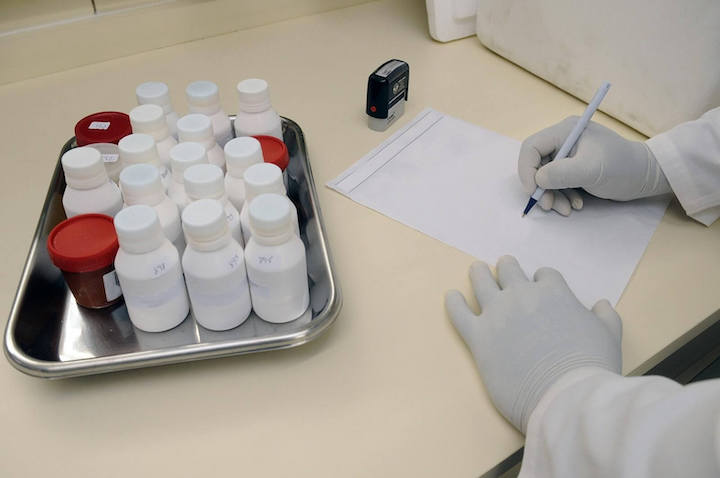 How to Write the Discussion Section of a Research Paper in 7 Steps
How to Write the Discussion Section of a Research Paper in 7 Steps
How to Write a Lab Report: Writing Advice on Basic Steps

What are lab reports? It is your initiation to communicating science. Lab report outlines resemble the format of peer-reviewed journal articles, with the latter being the foundation of scientific expertise. Therefore, your laboratory report must communicate your research distinctly and systematically. You should do your best for the reader to follow your logic, replicate your experiment, and comprehend your results. Moreover, they should be able to see how these results and their ramifications fit into the broader context of your area of expertise.
Sounds pretty complicated, doesn’t it? If so, then keep in mind that you can always get professional help. Otherwise, read through the following comprehensive guide and find out all the disaggregated step-by-step instructions on how to write a lab report on your own.
Laboratory Reports Sample
This style of report usually includes four main sections: Introduction, Methods, Results, and Discussion. To simplify terms referring to a lab report structure, they are sometimes called “IMRAD,” and it’s closely aligned with the scientific method. However, if you need to know how to structure a lab report from scratch, then include the following parts:
- Title – indicate the topic of your study;
- Abstract – outline your research goals, methods, outcomes, and conclusions;
- Introduction – provide the context required to comprehend the topic;
- Methods – specify the procedures and materials used in the experiment;
- Results – write up all expository and inferential statistical analyses;
- Discussion – explain and assess results and specify limitations;
- Conclusion – summarize the key findings of your experiment;
- References – enumerate all cited sources using a required style (like APA, MLA, etc.);
- Appendices – include lengthy materials, figures, tables, and so on.
So now, once we figured out the lab report layout typical components, let’s proceed to learn how to write lab report step by step. Below, we will focus on crafting the main parts in detail.

What is a Lab Report? Start with Introduction
Objective
Why did you decide to carry out this research?
Relative Size
About 20% of the total.
Verb Tense
Employ the present tense to denote instituted knowledge. However, if you need to refer to particular studies or to what you performed, employ the past tense.
How to start a lab report? Well, to make the long story short, the introduction puts your research in a specific context. In it, you should determine the framework of your study, explain the main terms and concepts, and describe the existing state of knowledge. Moreover, you should specify inconsistencies or gaps that have led you to the research, sum up what you performed, and declare your predictions and hypotheses.
Start off your laboratory report outline with an introduction containing the all-encompassing concepts and consistently narrow them down to your particular study. Then, when writing a lab report, stick to the appropriate sentence and paragraph style. Finally, remember that every paragraph should transition logically to the next one.
Details
- Framework
Specify your research’s framework, ensuring it is neither too general nor too confined. Check out laboratory report samples and revise available published projects on your subject for opinions, concepts, and scope ranges.
- Definitions
Explain key terms used in your lab report writing – you must provide terms’ definitions before you mention them. Do not forget that terms may vary depending on the study.
- Preliminary study
Represent a general yet concise overview of today’s status of knowledge in your thematic area. Do not overwrite it but be sure to introduce the most appropriate projects for your experiment. That should also gradually lead the reader to the significance of your study.
- Significance of your research
Disclose why your experiment is important – are you striving to fill a gap in the current research? Figuring out conflicting results? Exploring a new area of study? Specify what contribution your project will make to the current research.
- Your study’s goal
What did you assume to find? What was the ground of your assumption? Clarify your hypothesis, anticipation, and justification. Cite relevant research to certify your rationale and foster your hypothesis and anticipation.
- How you achieved the goal
Describe briefly how you tested your assumption. However, neither your methods nor any results details should be mentioned here. This part shouldn’t take more than a few sentences.
A Great Introduction SHOULD:
- Give a concise prerequisite of the study topic;
- Specify any requisite definitions (both common and specific);
- Disclose how your experiment fits into current research;
- Justify your assumption.
A Great Introduction should NOT:
- Be a comprehensive review – state as much information as is required for informing the reader on your project topic and sequentially presenting your hypothesis;
- Include any extra details that do not refer to your project;
- Describe a detailed reference of what you performed;
- State discussion or results.

Lab Reports Outline. Proceed with Methods
Objective
How did you carry out this study?
Relative Size
About 15% of the total.
Verb Tense
Constantly use the past tense while concluding the methods of your experiment.
This section of a lab reports layout is meant to specify sufficient detail of the methodology you used. It is required for a reader in case they would like to reiterate your project and reproduce your results. Many students struggle with how to make a lab report methods section since they are to balance between providing enough information and avoiding superfluous details. Therefore, we advise you to answer the following test question from time to time while writing, “Does someone really need this detail to repeat this study?”
Do not write this part as step-by-step instructions; instead, deliver a succinct summary of what you performed. You should also remember to refrain from referring to other research in this section, i.e., no citations either.
Details
- Research area
Outline your research area. Include details on a geographic location, topography, boundaries, size, and – if relevant – a habitat type.
- Organism
Specify details of age, gender, and other related information if a particular organism is part of your study.
- Materials
How to format a lab report materials section? Integrate used materials specifications when describing your experiment procedure. In particular, add concentrations of chemical solutions and other details required to reproduce your study, including model numbers of specialized lab equipment.
- Experiment
Write about the procedure in paragraph format; don’t apply numbered steps or a point form here. Also, specify the description of your experimental design, replicates, measurement methods, sample size, etc.
- Data analysis
State the statistical tests you applied, data processing, and significance level set, including any relevant specific calculations.
- Figures
If there is such a need, add diagrams of the study area, procedures, or equipment. Title and number them accordingly with references to a particular figure within the text.
A Great Methods Section SHOULD:
- Include sufficient details to enable an accurate replication of the experiment;
- Be written in a sequentially flowing paragraph format;
- State details on the statistical analysis, experiment, used materials, study site, and organism.
A Great Methods Section should NOT:
- Be a step-by-step guideline;
- Merely itemize a list of used materials;
- Include any other formatting than a paragraph;
- Refer to, cite, or compare to other studies.

How to Do a Lab Report. Go on with the Results
Objective
What did you find out?
Relative Size
About 15% of the total, except for figures and tables.
Verb Tense
Constantly use the past tense while summarizing the results of your study.
Write the results section referring to your hypotheses. I.e., make sure the reader can reveal your hypotheses in the introduction and then recognize the related results here. Add no raw data; instead, provide only analyzed or concluded data.
Any proper lab report format example proves that you should include tables and/or figures to demonstrate your results, embedding them within the text. Moreover, you need to present patterns and trends, underline significant findings, and highlight abnormal and meaningful data.
Given that the interpretation of your results would require a comparison with other studies, this part should only include the information related to your study. Hence, do not declare any statements rejecting or supporting your hypotheses; do not interpret your results either.
Details
- Description of the outcome
Referring to backing figures and tables, provide only summarized data and point out significant patterns and trends.
- Figures
Relevant lab reports examples suggest that graphs’ primary purpose is to visually represent your results.
- Tables
Insert tables to show more disaggregated and complex results if they do not lend themselves to text or figures.
- Appendix
Not every lab report definition includes this section, as it is optional. If you need to include any additional information or raw data, do so at the very end of your document, following the reference section.
A Great Results Section SHOULD:
- Specify statistical results and provide a summary;
- Report important findings; highlight patterns and trends; point out abnormal or valuable data;
- Contain relevant figures and tables referred to and integrated into the text.
A Great Results Section should NOT:
- Contain raw data;
- Reiterate numbers from figures and tables;
- Interpret your results;
- Include a comparison with other studies.

How to Сreate a Lab Report. Complete with Discussion
Objective
Why do we care in the first place?
Relative Size
About 40% of the total.
Verb Tense
The past tense – for referring to the results from your study or other ones supporting your hypothesis.
The present tense – for assuming the implication of your study.
The future or conditional tense – for putting forward your further study purposes.
If you don’t know how to do lab report discussion section, you should first grasp its purpose – the analysis of your experiment.
Therefore, you should first summarize your results concisely and tie them to your hypotheses. And afterward, you need to integrate them into the context of your area of research.
Don’t bother about how to title a lab report, as the Discussion section is its most crucial part. It is here that you disclose your unique ideas, concepts, and interpretations.
Details
- Confirm or reject hypotheses
Avoid declaring that you proved anything; instead, conclude whether the experiment’s results supported or rejected your hypotheses.
- Explain and compare results
Interpret your results and compare them to those of other studies. How do they differ, and why? Use literature to confirm your statements and generalizations.
- Debate factors affecting results
Discuss the anomalies (if any), inconsistencies, conjectures, or errors that may have affected your experiment’s results. Would you do anything differently in the case of reproducing the same study?
- Assess implications
Will your outcomes contribute to existing research, and how? Was your experiment important, and why?
- Suggest ideas for further research
Did your study bring forth questions for further research? What are the next steps in this area of expertise?
A Great Discussion Section SHOULD:
- Reflect the introduction in structure and framework;
- Confirm or reject your hypotheses;
- Describe how your outcomes compare to the current studies;
- Explain any issues or challenges;
- Suggest questions for further research.
A Great Discussion Section should NOT:
- Replicate detailed results;
- Pertain figures or tables;
- Declare “proving” of anything.
Final Words
So, what does a lab report look like? Even though its content employs the scientific method, its structure has the same shape as an hourglass. Remember this handy visual when writing lab reports.
The introduction starts extensively and narrows down to your particular study. Then, methods and outcomes keep concentrating only on your experiment. And finally, the discussion develops and goes back to the broader framework specified in your introduction.
We hope our “how to write a lab report example” above provided enough details for you to make it the best way. So, good luck!

